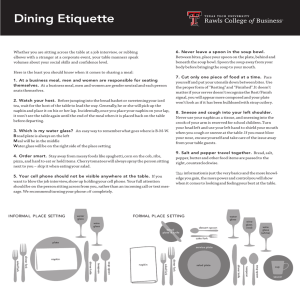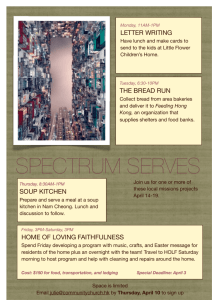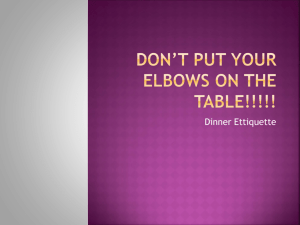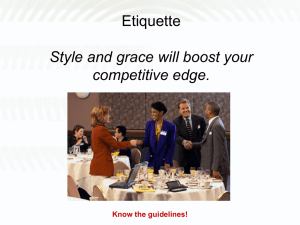Dining Success: A Simple Guide
advertisement
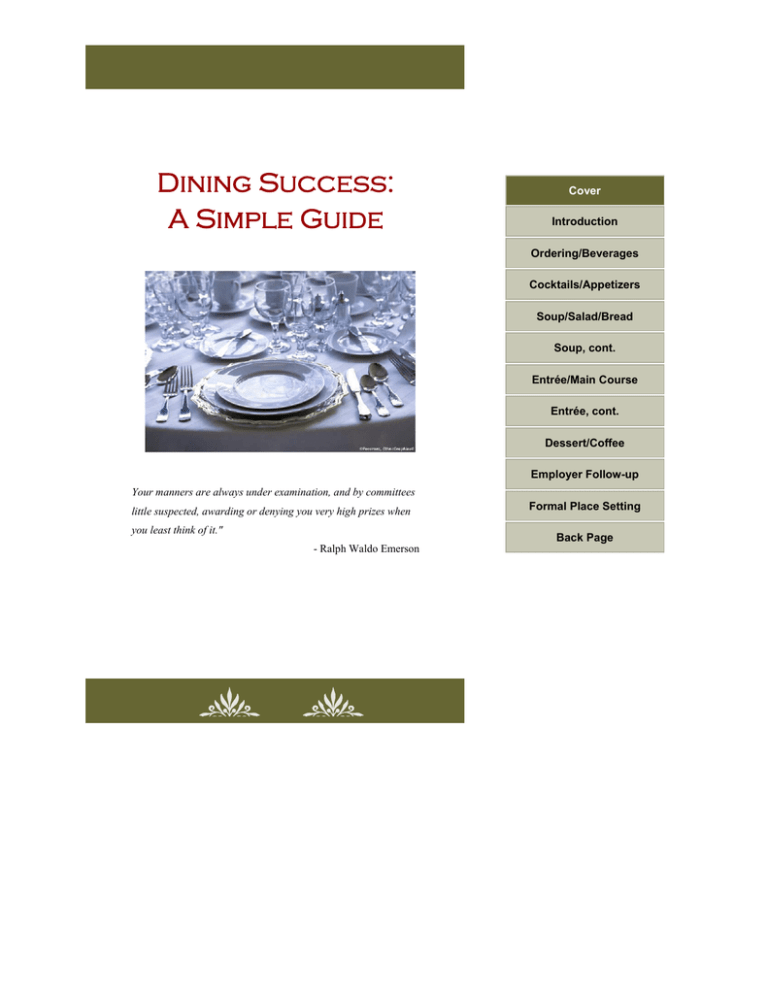
Dining Success: A Simple Guide Cover Introduction Ordering/Beverages Cocktails/Appetizers Soup/Salad/Bread Soup, cont. Entrée/Main Course Entrée, cont. Dessert/Coffee Employer Follow-up Your manners are always under examination, and by committees little suspected, awarding or denying you very high prizes when you least think of it." Formal Place Setting Back Page - Ralph Waldo Emerson Introduction Why this is an important skill to master? It might be part of your job: entertain clients, traveling, int’l business and customs Good skill to use in any capacity Most job interviews include a meal: while you might have impressive answers and resume, unimpressive social skills and poor table manners can leave a lasting, negative impression. Cover You don’t want to be unprepared or caught off guard: confidence is important Introduction Ordering/Beverages Cocktails/Appetizers What will employers be watching for? Dinner is a more relaxed environment in which you can demonstrate your conversation ability, social skills, etiquette, and personality. Don’t get too relaxed - you are still being interviewed, but enjoy the experience! They will watch you throughout the evening: ordering, interacting with the wait staff, eating, chewing, etc. Soup/Salad/Bread Soup, cont. Entrée/Main Course How should I prepare? Learn about where the dinner is taking place: at a person’s home, local pub, five-star restaurant, etc. Research a restaurant if in a new town and have advance knowledge. Think of conversational topics you would like to talk about and things to discuss if conversation lulls. Dinner conversations can often broaden beyond the focused job position. Be ready to ask questions about the company, the employer, the geographic location, etc. Entrée, cont. Dessert/Coffee Employer Follow-up Formal Place Setting Arrival ARRIVE ON TIME!!!! If you show up late, it sends a negative message to the employer. If coming on your own, be sure to arrive a few minutes early. This is especially true if you are unfamiliar with the restaurant and its location. Plan on extra time to find the locale, parking, etc. If arriving together, be aware that you are still being interviewed and observed at all times (so don’t pop any gum, pick at your eyebrows, wear a coat full of lint, etc.) Cell phones, pagers, and beeping watches should be turned off. Please do so now, if you haven’t already. Unless you have an urgent matter where you need to be reached, all communication devices should be turned off so that your conversation is not unnecessarily interrupted. Page 2 Back Page Attire Choosing what to wear: Do some preliminary research on dress codes (appropriate business attire) in your field. For example, accounting firms and law firms, generally tend to be very conservative and have strict rules on how they want their employees to present themselves to their clients. On the other hand, "creative" industries such as public-relations and advertising firms tend to give their employees more leeway and opt for a more "business-casual" look. If in doubt, always err on the conservative side. Who is ordering? Your host might take the liberty to order for you. Graciously accept what they order unless you have a food allergy. In that case, politely share with them your condition and ask for perhaps another recommendation. If you are unsure how the dish is prepared, simply ask the wait staff. If you are ordering for yourself remember the following: Don’t agonize over the menu. That can be interpreted as indecisiveness. Instead, you may ask for a recommendation from the host. Also, avoid ordering messy foods like pastas, juicy burgers, triple-decker sandwiches, corn on the cob, etc. Cocktails/Appetizers Soup/Salad/Bread Soup, cont. Entrée/Main Course Entrée, cont. Dessert/Coffee Is meal price a consideration? Introduction Ordering/Beverages Ordering and Beverages Cover Yes! Remember the cost of a meal when ordering. Do not select the most expensive item on the menu – that is presumptuous. Also, do not order the cheapest item. That could insult the employer. Instead, pick a moderately priced entrée and use the host’s selection as a gauge. Is it proper to order/partake in alcoholic beverages? Employer Follow-up Formal Place Setting Back Page Avoid all alcoholic beverages unless ordered by the host. If ordered by the host, order only one drink and only if you are of age. Drinking too much when dining out is one of the most disliked behaviors. Beer is acceptable to order, but make sure to pour the bottle contents into a glass. Wine is also acceptable, but remember to only have one drink at the most. What are some conversation tips? Do not mention work until after everyone has ordered. Page 3 Engage in table conversation that is pleasant but entirely free of controversial subjects: politics, religion, and other opinion-based topics should be avoided. Always be polite to the server. It is not necessary to thank him or her for every service provided, but make sure to thank him or her occasionally. Where should my hands be placed when not eating? When you are not eating, keep your hands in your lap or resting on the table (with wrists on the edge of the table). Elbows on the table are acceptable only between courses, not while eating. Remember, in order to make a good impression it is important to sit up straight at the table. Posture is important throughout the dinner, so arch back, shoulders back, and eyes forward! Cover Introduction Ordering/Beverages Cocktails/Appetizers What do I do with my napkin? The meal begins when the host unfolds his or her napkin. This is your signal to do the same. Place your napkin on your lap, completely unfolded if it is a small luncheon napkin or in half, lengthwise, if it is a large dinner napkin. Follow the host’s lead. During the meal, the napkin should remain on your lap and should be used to gently blot your mouth when needed. Entrée/Main Course Cocktail Hour/Appetizers Entrée, cont. How do I behave at a cocktail or social hour? An employer might invite you to a cocktail hour prior to dinner or simply to a social gathering with employees. While this environment is vastly different than a one-on-one interview, you shouldn’t assume it is less formal or that you are not being observed and evaluated. At a cocktail hour, food and drinks are typically served. If alcoholic beverages are available, you may have one drink and one drink only – and this is only if you are of age! You do not want to impair your senses and abilities and you do not want to be remembered for the number of drinks you consumed. Handling food and a drink can be tricky, so be sure you have a plate you can set a drink on and are able to handle both items with one hand. You will be meeting new people and during those introductions and you need to have your hand free to shake hands. This is how you do it: Take that cocktail napkin and put it between the ring and baby finger of the left hand. Then, spread the ring and middle fingers to act as a base for the plate of hors d'oeuvres. Use the thumb and index finger to hold the stem or base of the glass and to stabilize the top of the plate at the same time. As you need something, reach for it with the right Page 4 Soup/Salad/Bread Soup, cont. Dessert/Coffee Employer Follow-up Formal Place Setting Back Page hand, use it, then return it to the appropriate finger slot in the left hand before continuing. Keep your drink in your left hand. The reason is so that you can shake hands with someone quickly without having to transfer your drink to the other hand. Also, it prevents a wet or clammy handshake! If you are asked to wear a nametag, place it on the side of your chest according to your handshake. If you are right handed, place it on your righthand side. If you are left-handed, place it on the left portion of your chest. That way, when you extend your arm to a person, your nametag is turned towards that person for their better view. Introductions: Be ready to shake hands and be sure to fully extend your arm, clasp the person’s hand so that your thumb rests on the side of the hand, just below their wrist. Firmly grip the hand and shake once or twice. A weak grip can indicate a passive or intimidated personality and an overly firm handshake (“the Bone Crusher”) can show overeagerness and can actually be painful! Feel free to practice with friends and family until you are comfortable. (Practice now!) Should I order an appetizer? Take your cue from the employer. It is awkward when one person at the table is eating and the other is not. If an appetizer is ordered for the entire table, feel free to partake. Use a fork and knife to transfer the food onto a plate. How do I eat shrimp cocktail?* Use a cocktail/seafood fork to eat the shrimp which is the smallest fork in the table setting. It is located on the right hand side of your plate next to the spoon. Spear the shrimp with your fork and place it on your plate, if provided. Only cut the shrimp if it is served with a plate. Otherwise, eat the shrimp in bites directly off of your fork. If the tail (shell) still remains, cut it off with your fish knife (if provided) or dinner knife. Cut the shrimp in two pieces if it is not bite size. If you have your own dish of cocktail sauce, you may dip each piece in sauce with your cocktail fork and take your bite. If there is cocktail sauce provided for the entire table, spoon sauce to your bread plate or provided saucer to dip the shrimp. When finished, leave the fork on the plate underneath. * Note: If shrimp cocktail is served at a cocktail hour, often silverware is not provided at such a function. In this case, the shrimp should be small and able to be eaten in one piece. It is appropriate to use your fingers. Soup, Salad, and Bread Course What utensils do you use? Page 5 Cover Introduction Ordering/Beverages Cocktails/Appetizers Soup/Salad/Bread Soup, cont. Entrée/Main Course Entrée, cont. Dessert/Coffee Employer Follow-up Formal Place Setting Back Page The salad fork is the fork furthest to the left (unless there is a fish fork). A rule of thumb about utensils: you work from the outside in towards your dinner plate. Typically the salad fork will be smaller than the dinner fork, but not always. The bread plate will be on your top left and should be accompanied by a butter knife. If there is not a butter knife, you may use your dinner knife instead. The knife should rest completely on the plate at all times. How to eat a leaf/Greek salad You may use your knife to cut up lettuce, if the lettuce leaves are too big. Be careful to cut or spear the tomatoes and olives. If they roll off your plate, simply pick the item up and place it on an unused edge of your plate. What if there is something in your mouth you do not want to swallow? You may take a bite and find a pit, gristle, or other “icky” item. Move the food forward with your tongue onto your fork and discreetly place it back on the side of your plate. The only time you may remove food from your mouth with your fingers is if you are eating fish and encounter a bone. In this case, you would place the bones from your fingers to the side of your plate. How to pass bread/rolls (and other “community foods”) Bread or rolls should be passed counter-clockwise. It is acceptable to offer bread to the person on your left, while holding the basket/plate. However, all “community foods” like the breadbasket and salad dressing should be passed counter-clockwise (to the right). Creamers, syrup pitchers, gravyboats, and salad dressing should be passed with the handle pointed toward the recipient. How to butter and eat bread/rolls Place bread or roll on your bread plate (found on the left hand side of your place setting). You will either have a butter plate where you can take a pat of butter with your butter knife OR you will have wrapped butter of which you can take a packet (no more than two). Remove the foil and using your individual butter knife, slide it onto the bread plate. Fold the foil and place it onto the edge of the bread plate. Break off a bite-size piece of the bread with your fingers, butter it, then eat it. Do not butter the entire roll at one time. Also, do not bite into a large portion of buttered bread. You eat bread bite by buttered bite! Soup If a spoon is not served with your soup bowl, the soup spoon will be located on the right-hand side of the place setting near your knife. It has a broad, round shape as opposed to a regular oval-shaped teaspoon. Page 6 Cover Introduction Ordering/Beverages Cocktails/Appetizers Soup/Salad/Bread Soup, cont. Entrée/Main Course Entrée, cont. Dessert/Coffee Employer Follow-up Formal Place Setting Back Page Soup should be spooned from front to back, away from you and towards the back of the soup bowl. Also, be aware of how you are gripping the utensil: your thumb should be on the top of the spoon handle and not gripped like a bicycle handlebar! When eating soup, be sure not to slurp and avoid leaning down and into your bowl. Food should be brought to your mouth and not vice versa. Crackers maybe added to soup (such as oyster crackers) but they may not be crumbled. You may tilt your soup bowl to get to the last portion of your soup. Be sure to tilt the bowl away from you and use the same front-back motion with your soup spoon to get a bite. When you are finished, the soup spoon should rest on the side of your plate and not inside the bowl. Utensils should never be left inside a bowl or dish, sticking out. They should always reside on the accompanying plate or saucer. Cover Introduction Ordering/Beverages Cocktails/Appetizers Soup/Salad/Bread Entrée or Main Course The meal arrives…. When do you dig in? Make sure that everyone at the table has been served before taking a bite. Generally it’s a good rule of thumb to wait until the host begins his or her meal. Mistakes and wrong orders Kitchen errors happen: you may get the wrong dish or perhaps your order may have been improperly prepared (food undercooked, burned, etc.) In any case, don’t make a scene and don’t complain. Simply tell the waiter the problem and suggest what you would like to have done (new order, reheat, etc.) Be sure to address the problem rather than ignoring it. Some employers will even tip off a waiter to purposely change your order just to watch your reaction. They want to see that a person is assertive, direct, and polite. Salt and pepper It’s improper to season your food without first tasting it. It’s an insult to the chef and may tell the employer that you make up your mind before you obtain any facts. If the meal needs seasoning after you have tried a bite, then you may add salt, pepper, etc. If someone asks for the salt or pepper, hand both to the person as a set; they always travel as a pair. Utensils and what to do with them You should use the remaining fork on the left hand side of the place setting. Page 7 Soup, cont. Entrée/Main Course Entrée, cont. Dessert/Coffee Employer Follow-up Formal Place Setting Back Page the waiter for one. Pasta may come with a pasta spoon which can be used with a fork to twirl noodles into a ready bite. Dip the fork in the pasta with your right hand and then steady the fork tines against the spoon in your left hand to twirl the pasta around the fork in a manageable bite. Steaks and meats may also come with a steak knife which should be used to cut the meat. Your knife should rest on the edge of your plate when not being used as well as your fork. The resting positions are: 10 and 4 o’clock position for knife with the blade facing inwards. 2 and 8 o’clock position for fork, tines down. Never rest a used knife on the table. Cover Introduction Ordering/Beverages Cutting meat There are two acceptable ways to use your utensils: In the Continental fashion (commonly found in Europe) the person cuts food, usually one bite at a time, fork remains in the left hand, tines pointed down to pick food up and bring it to the mouth. In the American standard, the person cuts a few bites of food. Once this is done, s/he places the knife across the top of the plate with the edge facing him or her. The fork is switched from the left to the right hand, fork tines are facing up to bring food to the mouth. If you are using the American standard, do not cut more than two or three bites of food at a time. Chewing Make sure you chew with your mouth closed. You will be expected to carry on conversation and an employer will more than likely be asking you questions. It is impossible to not speak while chewing, so just be sure to have a small amount of food in your mouth. That means you should be preparing small bites of food throughout the meal rather than loading down your fork! Cocktails/Appetizers Soup/Salad/Bread Soup, cont. Entrée/Main Course Entrée, cont. Dessert/Coffee Employer Follow-up Formal Place Setting What to do with your napkin Your napkin should still be in your lap and used to wipe your mouth before taking a drink from your glass and to periodically wipe your mouth. Sharing food It is appropriate to share food when others at the table are willing to do so. However, unless an employer asks you to share food, refrain from doing so. Typically that is an action reserved for people who know one another on a more personal level. If you do share food, ask your server for additional small, clean plates. Reasons to excuse yourself You should excuse yourself to blow your nose, if you are feeling ill, if you Page 8 Back Page If you do leave, place your napkin on your seat or arm of your chair when excusing yourself during the meal. It is not appropriate to place a soiled napkin on the table while people are still eating. Spills and other mishaps If you spill something, clean it up at the table or excuse yourself to the restroom if needed. Apologize to anyone your slight mishap may have inconvenienced. If you drop a plate or food item, notify a wait staff to help you clear the mess. If you drop a utensil, let it stay on the carpet and have a wait staff pick it up and ask for another. Unless there is food on it, just let it be. Spilled drinks: Use your napkin immediately. Offer it to the person, don’t assist their efforts Cover Introduction Ordering/Beverages Cocktails/Appetizers What to do when finished Lay your fork and knife diagonally across your plate. These utensils should be side by side with the fork tines pointed down and the knife blade facing inwards, towards you. Typical placement is at 10 and 4 o’clock. Any unused silverware may be left on the table. It is inappropriate to request a doggy bag when you are a guest. You may move your dessert utensils down after the main course has been removed. Do not push your plates away from you and do not stack them. Leave all items where they are, just making sure that utensils are on plates. Again, you may compliment the meal and/or the server, but do not draw attention to being too full (with comments like, “That was so good I could burst!”) Employer Follow-up Dessert and coffee/Employer follow-up Formal Place Setting What utensils do I use? Your dessert utensils are located at the top of your place setting. There will be a fork and/or a spoon depending on the type of dessert served. Use your fork or spoon to cut your dessert into small bite-sized pieces as you eat. When you are finished, leave the utensil on the dessert plate. If your dessert is in a bowl, then place your utensil on the saucer underneath. Back Page Do I accept coffee or an after-dinner drink? If your host orders coffee, follow suit or have a beverage to share. It is awkward to have one diner partaking in something when the other is not. Page 9 Soup/Salad/Bread Soup, cont. Entrée/Main Course Entrée, cont. Dessert/Coffee Only if your host orders an alcoholic after-dinner drink is it appropriate to do so. If your host orders an alcoholic drink and you do not want to order one, you may order coffee instead or request a refill of your dinner beverage. Keep in mind that if you have already consumed an alcoholic beverage with any part of the meal that it is probably not a good idea to order another beverage that contains alcohol. The host may be watching to see how much you drink and you also want to be your sharpest! What do I do with my napkin? Once your dessert is finished, take the cue from your host to remove your napkin from your lap. Place your napkin casually to the left or right of your plate, but never on your plate. Do not refold it but also do not wad it up. Who pays for the bill? The person who extended the invitation (regardless of gender) is responsible for paying the bill. Introduction Ordering/Beverages Cocktails/Appetizers Soup/Salad/Bread Thanking the host Firmly shake the hand of your host and thank him/her with a smile and good eye contact. If this is the end of your interview, be sure to finalize follow-up details about your interview process (gather business cards, ask when you will hear word about their decision, find out if you need to send materials, etc.) Thank You Letter Be sure to send a thank you letter to the employer after the interview/ dinner. The note can be either handwritten in ink or typed (depending on your handwriting), but make sure to proofread it carefully. Corporate employers typically expect a typed letter. Take time to think through the wording of your letter. It should be concise and sincere. Place the letter on plain or personal stationery, not on letterhead from your current place of employment. Thank you notes should be sent within 48 hours of the interview, but late notes are better than none at all. Cover Thank yous can be sent to individuals and/or the office; make sure to include everyone’s name who attended dinner. It would even be better to send a separate thank you note to each host. Page 10 Soup, cont. Entrée/Main Course Entrée, cont. Dessert/Coffee Employer Follow-up Formal Place Setting Back Page Formal Dinner Place Setting 1. 2. 3. 4. 5. 6. 7. 8. Napkin Salad Fork Dinner or Main Course Fork Fish Fork Soup Bowl & Plate Dinner Plate Dinner Knife Fish Knife 9. 10. 11. 12. 13. 14. 15. Soup Spoon Bread & Butter Plate Butter Knife Dessert Spoon and Cake Fork Sterling Water Goblet Red Wine Goblet White Wine Goblet Cover Introduction Ordering/Beverages Cocktails/Appetizers Soup/Salad/Bread Soup, cont. Entrée/Main Course Entrée, cont. Dessert/Coffee Employer Follow-up Formal Place Setting Back Page Informal Dinner Place Setting Same as above except remove the following: 4. Fish Fork 8. Fish Knife 12. Dessert Spoon and Cake Fork 14. Red Wine Goblet 15. White Wine Goblet Page 11 Cover Introduction Ordering/Beverages Cocktails/Appetizers Soup/Salad/Bread Soup, cont. Entrée/Main Course Entrée, cont. Dessert/Coffee Employer Follow-up Thomas Building, Room 103 5241 N Maple Ave M/S TA61 Fresno, CA 93740-8027 Phone: 559.278.2381 Fax: 559.278.6483 www.fresnostate.edu/careers www.facebook.com/fscareer Dining Success: A Simple Guide Formal Place Setting Back Page
